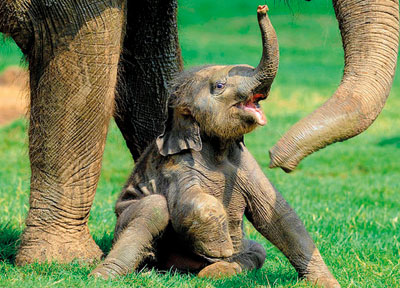Despite their
tremendous size and strength, elephants make for very gentle mothers. Elephant calves are born into a matriarchal
community – the herd is led by the largest and most experienced female. She knows best where to find food and water and how to avoid danger. Males
typically leave the group just as they become
teenagers, usually in their 14th year. The females, however, form a close knit group, and raise their calves together. These “allmothers” – the young calf’s grandmothers,
sisters, aunts and even cousins – help in every aspect of child rearing.
Like humans, elephants too use touch as a way to
communicate love and affection. Young calves are frequently stroked by the adults around them. This stroking is simply one of many uses that
elephants have for their trunks.
Though a calf will suck on its trunk (much like you sucked on your thumb as a baby) they are also constantly learning from the adults around them. They learn how to use their trunks to squirt water over their backs while bathing or how to pluck food to eat or pick up things that block their path.
You see, it takes a lot of practice to master the 40,000 odd muscles that give an elephant’s long snout such dexterity. But all this comes much later. The first great
challenge of a calf’s life is simply standing up.
As her 22 month
pregnancy draws to a close, a mother knows she’s approaching the time of birth. Communicating with a series of low-frequency sounds – trumpets,
rumbles, squeaks, squeals and snorts – some of which are too low for us to even hear, mothers will tell other females around her that she’ll need their help soon. At least one other elephant and
sometimes the whole herd will stand guard while she goes into labour. Normally she gives birth to a single hefty calf – twins are rare.
Soon after birth, a
mother will help her
little one come to its feet so it can begin nursing.
New born calves have hearty appetites, typically consuming over 10 litres of milk a day! It’s a rich diet. Elephant milk has many times more fat and protein in it than cow’s milk.
Like humans, elephants are very social animals and also like human babies, much of their brain’s
development happens
outside the womb.
As adults, elephants have some of the largest brains you’ll see in land animals. However, when they’re born, the brain is only 30% – 40% the size of an adult’s.
This is why
elephant calves remain
for many years with
their mother, carefully
learning how to live in a herd, forage for food and spot predators. Weaning only begins after the first year of a calf’s life, but
the calf will remain
dependent on its mother for up to 3 – 5 years of its life. Even afterwards the child, particularly the female, will stay with the herd.
Female elephants begin reproducing at 11 years and continue through their fifties, giving birth to one calf every five years or so. Luckily, well before they give birth to their first calf, young females have had experience of caring
for other babies in the herd. This practice is
crucial, since a calf’s
survival often depends on his or her mother’s skill. |


